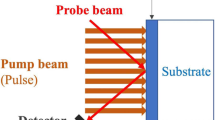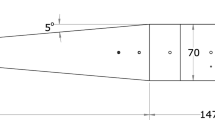Abstract
An experimental technique is investigated to optically measure the explosive impulse produced by laboratory-scale spherical charges detonated in air. Explosive impulse has historically been calculated from temporal pressure measurements obtained via piezoelectric transducers. The presented technique instead combines schlieren flow visualization and high-speed digital imaging to optically measure explosive impulse. Prior to an explosive event, schlieren system calibration is performed using known light-ray refractions and resulting digital image intensities. Explosive charges are detonated in the test section of a schlieren system and imaged by a high-speed digital camera in pseudo-streak mode. Spatiotemporal schlieren intensity maps are converted using an Abel deconvolution, Rankine-Hugoniot jump equations, ideal gas law, triangular temperature decay profile, and Schardin’s standard photometric technique to yield spatiotemporal pressure maps. Temporal integration of individual pixel pressure profiles over the positive pressure duration of the shock wave yields the explosive impulse generated for a given radial standoff. Calculated explosive impulses are shown to exhibit good agreement between optically derived values and pencil gage pressure transducers.









Similar content being viewed by others
Abbreviations
- D ij :
-
Linear operator
- EBW:
-
Exploding bridgewire
- f :
-
Focal length
- Hg–Xe:
-
Mercury–Xenon
- I + :
-
Positive phase of explosive impulse
- k :
-
Gladstone-dale coefficient
- M :
-
Mach number
- N :
-
Number of intervals
- P :
-
Pressure
- PETN:
-
Pentaerythritol tetranitrate
- P 0 :
-
Atmospheric pressure
- P s :
-
Peak shock wave pressure
- R :
-
Lens radius
- r :
-
Radial lens coordinate
- r i :
-
Distance from center of object of interest
- r 0 :
-
Radial lens coordinate exhibiting luminance
- R air :
-
Air gas constant
- RDX:
-
Cyclotrimethylene trinitramine
- T :
-
Temperature
- T max :
-
Peak shock wave temperature
- T min :
-
Temperature at t a + T +
- t a :
-
Shock wave time of arrival
- t m :
-
Time vector
- T + :
-
Positive pressure phase duration
- w :
-
Graded filter width
- Δr :
-
Data spacing interval
- δ :
-
Normalized refractive index difference
- γ :
-
Specific heat ratio
- ε :
-
Refraction angle
- ε min :
-
Minimum refraction angle
- ε 0 :
-
Lens refraction angle constant
- η :
-
Refractive index
- η 0 :
-
Refractive index at ambient conditions
- ρ :
-
Air density
- ρ e :
-
Energetic material pressing density
References
Baker W (1973) Explosions in air. University of Texas Press, Austin
Bigger RP (2008) Chemical vapor plume detection using the schlieren optical method. The Pennsylvania State University, Thesis
Biss MM (2009) Characterization of blasts from laboratory-scale composite explosive charges. Dissertation, The Pennsylvania State University
Biss MM, Settles GS (2010) On the use of composite charges to determine insensitive explosive material properties at the laboratory scale. Propellants, Explos, Pyrotech 35(5):452–460
Dasch C (1992) One-dimensional tomography: a comparison of Abel, onion-peeling, and filtered backprojection methods. Appl Opt 31(8s):1146–1152
Dewey J (1964) The air velocity in blast waves from TNT explosions. Proc R Soc Lond Ser A Math Phys Sci 279(1378):366–385
Dewey JM (1971) The properties of a blast wave obtained from an analysis of the particle trajectories. Proc R Soc Lond Ser A Math Phys Sci 324(1558):275–299
Ethridge N (1965) A procedure for reading and smoothing pressure-time data from H.E. and nuclear explosions. BRL-TR-1691
Gruschka HD, Wecken F (1971) Gasdynamic theory of a detonation. Gordon and breach. Science Publishers Inc, New York
Hargather MJ, Settles GS (2007) Optical measurement and scaling of blasts from gram-range explosive charges. Shock Waves 17(4):215–223
Hargather MJ, Settles GS (2012) A comparison of three quantitative schlieren techniques. Opt Lasers Eng 50:8–17
Huygens C (1690) Trait de la Lumiere. Leyden
Kinney GF, Graham KJ (1985) Explosive shocks in air. Springer, New York
Kleine H et al (2003) Studies of the TNT equivalence of silver azide charges. Shock Waves 13(2):123–138
Kolhe PS, Agrawal AK (2009) Abel inversion of deflectometric data: comparison of accuracy and noise propagation of existing techniques. Appl Opt 48(20):3894–3902
Moffat RJ (1988) Describing the uncertainties in experimental results. Exp Therm Fluid Sci 1:3–17
Ostrach S (1952) An analysis of laminar free-convection flow and heat transfer about a flat plate parallel to the direction of the generating body force. NACA TN-2635
Schardin H (1947) Toepler’s schlieren method: basic principles for its use and quantitative evaluation. The David Taylor Model Basin, United States Navy, Translation 156
Rahman S et al (2007) Pressure measurements in laboratory-scale blast wave flow fields. Rev Sci Instrum 78(12):1251061–12510611
Settles GS (2001) Schlieren and shadowgraph techniques: visualizing phenomena in transparent media. Springer, Berlin
Acknowledgments
We would like to acknowledge the U.S. Army Research Laboratory’s Lethality Division Innovation Program and the National Research Council Postdoctoral Fellowship Program for funding of this research. We would like to acknowledge Mr. Roy Maulbetsch, Mr. Terry Piatt, and Mrs. Lori Pridgeon of the Ingredient, Formulation, & Processing Team for pressing of the energetic samples and Mr. Richard Benjamin, Mr. William Sickels, Mr. Ray Sparks, Mr. Gene Summers, and Mr. Ronnie Thompson of the Detonation Science Team for their assistance in conducting these experiments, and Ms. Susan Corley at DSC Laboratories for providing the linearly graded filters. Lastly, we would like to acknowledge Dr. Michael Hargather at New Mexico Tech for his thoughtful discussions and insight.
Author information
Authors and Affiliations
Corresponding author
Rights and permissions
About this article
Cite this article
Biss, M.M., McNesby, K.L. Optically measured explosive impulse. Exp Fluids 55, 1749 (2014). https://doi.org/10.1007/s00348-014-1749-x
Received:
Revised:
Accepted:
Published:
DOI: https://doi.org/10.1007/s00348-014-1749-x




